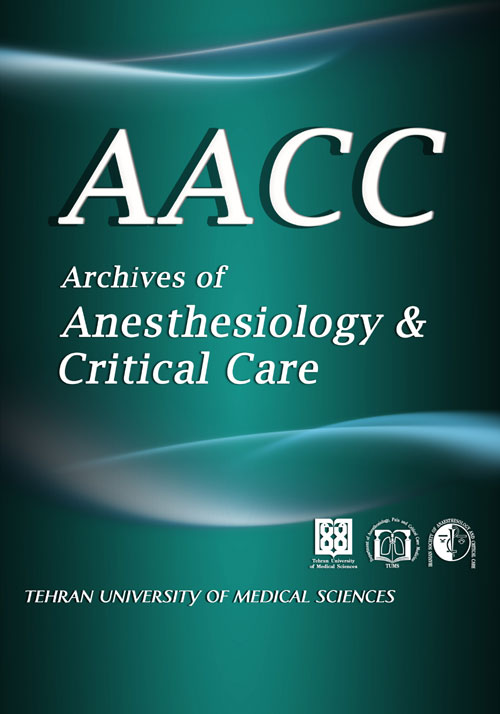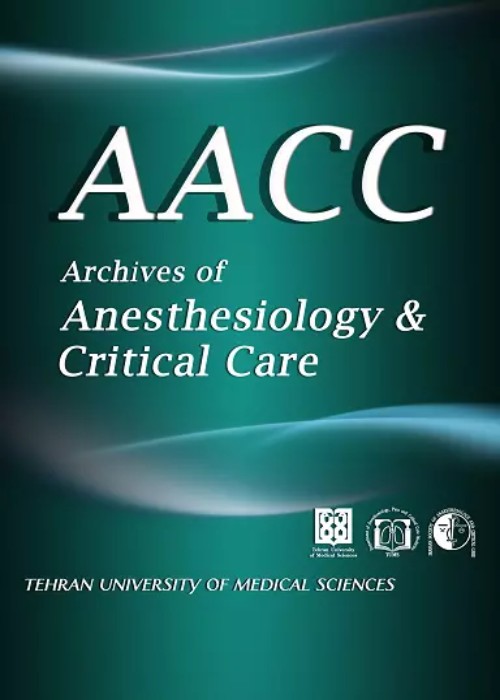فهرست مطالب

Archives of Anesthesiology and Critical Care
Volume:1 Issue: 1, Winter 2015
- تاریخ انتشار: 1394/03/20
- تعداد عناوین: 8
-
-
Pages 1-2The first issue of the Archives of Anesthesiology and Critical Care (AACC) appears on the website and reaches your hands after hard endeavors and labor of all concerned. It is a matter of immense pleasure that we could launch the first AACC after a long spell of almost eighty years ever since the first university of medicine came into being in the country. It took us some time to select a title for the journal as we intended to include the suggestions and aspirations of all, and again it entailed some time to select the editorial team and including experts in the field from both within the country and across the planet. The ultimate selection of the editorial team imparts a heterogeneous look to the journal which is what we should be proud of and that what we had been aiming at. While making the selection, inclusion had been our goal and not exclusion. Luckily, all accepted our humble invitation to be members of the editorial team and promised to help the newly launched journal through their active participation and critical insight.
-
Pages 3-7BackgroundWe aimed to compare the effect of albumin 5% in half normal saline (half NS) versus normal saline (NS) infusion on the plasma viscosity in the near-normal physiological condition. According to the high oncotic pressure of albumin along with prolonged half-life of its molecules in comparison to NS in the intra-vascular compartment, it has been proposed that a more significant reduction of the plasma viscosity might be expected after the infusion of albumin.MethodsA total of 56 patients referring to the general operating room for their elective minor surgeries were evenly divided into two groups (V1, V2). It was calculated that 28 patients were needed to be enroll in each study group to detect a difference as big as 0.15 millipoise (mPa.s) with a statistical power of 80%. The V1 group received 1000 ml of NS but the V2 group received 1000 ml of recombinant albumin 5% in half NS within one hour, as fluid replacement therapy, during the intra-operative period. We have designed a simple measurement system according to Poiseuille’s formula by which the viscosity value could be measured reliably since the system was calibrated frequently using distilled water as a reference.ResultsThe mean value of the pre-operative plasma viscosity of the patients was 1. 73 ± 0.25 mPa.s and 1.76 ± 0.21 mPa.s in V1 and V2 groups respectively. After the infusion of the fluids, the mean viscosity values decreased to 1. 68 ± 0.30 mPa.s and 1.66 ± 0.17mPa.s in V1 and V2 groups respectively (p= 0.37).ConclusionThe plasma viscosity reduction in patients of V2 group was not significantly different from that of V1 group.Keywords: plasma viscosity, albumin, normal saline, Poiseuille's formula
-
Pages 8-12BackgroundTracheal intubation is used in general anesthesia and often leads to traumatization of the airway mucosa. These complications can cause postoperative morbidity. This study was designed to determine the effect of ketamine spraying on the endotracheal tube cuff on sore throat, cough, and hoarseness during the first 24 hours of the postoperative period.Methods120 healthy women with term singleton pregnancy scheduled for elective term cesarean delivery under general anesthesia were enrolled. Patients were randomized into two equal groups. 1 ml (50 mg) ketamine was sprayed on the endotracheal tube cuff in group K as a study group and 1 ml normal saline was sprayed on the endotracheal tube cuff in group N as a control group. The patients were interviewed for sore throat, cough, and hoarseness at 1, 6 and 24 hours after general anesthesia.ResultsIn group K, no patient reported sore throat, cough and hoarseness in the first hours after surgery. However at the same time in group N the incidence of these symptoms was significantly higher than group K. The incidence of combined moderate and severe sore throat, cough and hoarseness was significantly lower in group K compared with group N, not only in 6 hours after surgery (1.67%, 0, 0 in group K vs 13.34%, 18.34%, 16.68% in group N, p<0.05) but also 24 hours after operation (1.67%, 0, 0 in group K vs13.3%, 16.6%, 11.67% in group N, p<0.05).ConclusionKetamine spraying on the endotracheal tube cuff reduces the incidence of sore throat, hoarseness and cough in patients undergoing operation under general anesthesia.Keywords: ketamine, general anesthesia, sore throat
-
Pages 13-17BackgroundEmergence delirium (ED) is a frequent postoperative complication in children. Its prevalence is about 25-80% and is observed more commonly with rapid-acting volatile anesthetics than the older inhalation agents.Methods30 patients aging between 2 to 8 years were included in this randomized double blind study. We compared the effect of combination of two anesthetic drugs, Propofol-Ketamine and Sevoflurane- Ketamine, on ED and pain after general anesthesia in pediatric patients undergoing interventional cardiac angiography. Agitation was measured by PAED (Pediatric Anesthesia Emergence Delirium) scoring system) and pain by the CHEOPS (Children’s Hospital of Eastern Ontario Scale).ResultsEmergence delirium in 10th minute of recovery was higher in propofol group (7.6±4.47 vs 5.07±3.31, p=0.047) but it was the same between the groups during the rest of recovery times. Pain scores were higher only at the moment of entrance to recovery room in sevoflurane group (6.27±1.99 vs 5.1±1.06, p<0.001). Mean recovery time was shorter in the sevoflurane group than in the propofol group (33.83±15.239 vs 51.67±20.585, p=0.02). Nausea and vomitting was more frequent in the sevoflurane group (6.6% vs 0%, p, 0.001), which needed no treatment.ConclusionThere are some minor differences between sevoflurane-ketamine and propofol-ketamine anesthesia. If the length of recovery is not an issue and the patients are not at high risk of nausea and vomiting, either sevoflurane-ketamine combined anesthesia or propofol-ketamine infusion can be suitably used to anesthetise patients for the pediatric cardiac catheterization procedures.Keywords: Ketamine, Propofol, Sevoflurane, Ketofol, Pediatric cardiac catheterization, emergence delirium
-
Pages 18-20BackgroundAlthough a variety of methods have been suggested to reduce stress, anxiety and pain intensity due to spinal needle skin puncture, their adverse effects restrict theirs widespread administration. In this study we evaluated the effects of oral Tizanidine on the reduction of pain caused by spinal needle puncture and hemodynamic responses.MethodsIn this double blind randomized clinical trial, 52 patients who were scheduled for elective surgeries under spinal anesthesia were recruited. They were randomly allocated in 2 groups of case and control. In the case group 4mg oral Tizanidine was administered to patients one hour before surgery while control group received placebo Heart rate, systolic and diastolic blood pressure were recorded exactly before spinal needle puncture and 1,3 and 5 minutes after spinal anesthesia.ResultsThe mean average of pain score was significantly lower in case group (p< 0.001). Also hemodynamic variables, in terms of heart rate and diastolic blood pressure, were statistically different between two groups (p=0.04 and p=0.02); however, the difference between systolic blood pressure was not significant between two groups.ConclusionPremedication with 4mg oral Tizanidine produced stability in blood pressure and heart rate during surgery and reduced pain intensity caused by needle puncture.Keywords: Tizanidine, premedication, spinal anesthesia, pain, hemodynamic response
-
Pages 21-26BackgroundKetamine is the only anesthetic agent that leads to an increase of blood pressure and heart rate by activation of sympathetic nervous system. However, there is a controversy about this effect of ketamine especially if used in small dosage. We proposed to evaluate the hemodynamic effect of small dose of ketamine during Phacoemulsification.MethodsOne hundred patients of ASA physical status I-III were chosen for this prospective, randomized, double-blind placebo-control study. Our patients were assigned randomly to two groups, ketamine group (n=50) and a control group (n=50). After premedication, 0.15 mg/kg ketamine was injected intravenously in ketamine group. After three minutes Phacoemulsification was begun under topical anesthesia. The hemodynamic variables were recorded during the procedure and compared between two groups.ResultsThe systolic, diastolic and mean blood pressure were statistically significantly higher in the ketamine group (p<0.001) during the procedure. The heart rate during operation was higher in the ketamine group compared to control group (p<0.001). 46 (92%) patients in the ketamine group and 38 (76%) patients in the control group were satisfied according to surgeons (p=0. 001). Nausea and vomiting occurred at similar rates in each group. Also, hallucination and other psychological events did not occur in either of the groups.ConclusionWe found that systolic, diastolic, mean arterial blood pressure in patients who received small dose of ketamine were higher during the operation.Keywords: ketamine, blood pressure, Phacoemulsification
-
Pages 27-33Acute respiratory distress syndrome (ARDS) is a complex disorder of heterogeneous etiologies characterized by a consistent, recognizable pattern of lung injury and a potentially devastating form of acute inflammatory lung injury with a high short-term mortality rate and significant long-term consequences among survivors. Recently, the new definition of ARDS has been published, and this definition suggested severity-oriented respiratory treatment by introducing three levels of severity according to PaO2/FiO2 and positive end-expiratory pressure. Supportive care, principally with mechanical ventilation, remains the cornerstone of therapy from maintaining normal physiological parameters to avoiding ventilator-induced lung injury while providing adequate gas exchange. Basic elements of this strategy consist of avoiding lung overdistension by limiting tidal volumes and airway pressures, use of PEEP with or without lung recruitment maneuvers in patients with severe ARDS. This review focuses on changes in ARDS definition, epidemiology, clinical and basic research, and current and future directions in treatment.Keywords: acute respiratory distress syndrome, Berlin definition, pathophysiology
-
Pages 34-36Spinal muscular atrophies (SMAs) represent a rare group of inherited disorders that cause progressive degeneration of the anterior horn cells of the spinal cord. The exact cause of the degeneration is unknown. Loss of these cells results in a progressive lower motor neuron disease that has no sensory involvement and that is manifested as hypotonia, weakness, and progressive paralysis. Kugelberg Welander spinal muscular atrophy (also known as Wohlfart-Kugelberg-Welander syndrome or mild SMA) is a milder form of SMA, with symptoms typically presenting after age 18 months. Here in we report a case of anesthetic management of a patient with Kugelberg Welander disease who was refered for squint surgery and also we reviewed some other cases of SMA patients receiving different types of anesthesia.Keywords: spinal muscular atrophy, squint surgery, muscle relaxant


